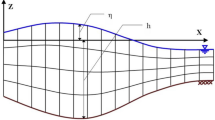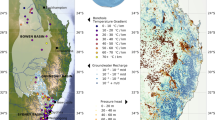Abstract
Concern has long been expressed that ancient Egyptian temples alongside the Nile deteriorate with time. Deteriorations were usually associated with annual inundations. When flood waters receded, salt deposits attacked the porous sandstone, reducing it to sand, and thus destroying the foundations. With the construction of the first dam, and of the High Dam near Aswan (in 1965), the annual inundations were eliminated. However, monitoring of the deterioration continued, especially in the Thebes–Karnak area1, where the temples are particularly numerous and important. The dam's construction was generally considered beneficial2 mostly because earlier causes of land salinization were eliminated. But this consensus was based on hydrological, climatological and chemical data1 and was only qualitative, and it has not been possible to answer this question even semi-quantitatively. However, visual observation indicates that some form of deterioration, due to salts appearing at the foundation of some monuments in Egypt, still takes place. Consequently, a deeper understanding of salinization processes is needed. We describe here a computer simulation of the flow of saline water in the area of the Great Temple of Karnak, to determine whether salinization in the post-dam, that is, present time, is a serious threat to the antiquities there.
This is a preview of subscription content, access via your institution
Access options
Subscribe to this journal
Receive 51 print issues and online access
$199.00 per year
only $3.90 per issue
Buy this article
- Purchase on Springer Link
- Instant access to full article PDF
Prices may be subject to local taxes which are calculated during checkout
Similar content being viewed by others
References
Traunecker, C. Kêmi 20, 195 (1970); 20, 213 (1970); 21, 177 (1971); 21, 197 (1971); Karnak 5, 119 (1975); 5, 131 (1975).
Lauffray, J. Le Courrier du CNRS 9, 28 (1973).
Attia, M. L. Geological Survey of Egypt-Deposits in the Nile Valley and the Delta (Government Press, Cairo, 1954).
Hume, W. F. Survey of Egypt-Geology of Egypt (Government Press, Cairo, 1925).
Lyons, H. G. The Physiography of the Nile River and its Basins (Finance Department of Egyptian Government, Cairo, 1906).
Conservation Problems in Egypt (UNESCO Consultant Report, Contract No. 33.591, 1970).
Author information
Authors and Affiliations
Rights and permissions
About this article
Cite this article
Billard, T., Burns, G. Solution of the continuity equation for the Karnak area. Nature 285, 654–655 (1980). https://doi.org/10.1038/285654a0
Received:
Accepted:
Issue Date:
DOI: https://doi.org/10.1038/285654a0
This article is cited by
-
Deterioration of our cultural heritage
Nature (1991)
Comments
By submitting a comment you agree to abide by our Terms and Community Guidelines. If you find something abusive or that does not comply with our terms or guidelines please flag it as inappropriate.



